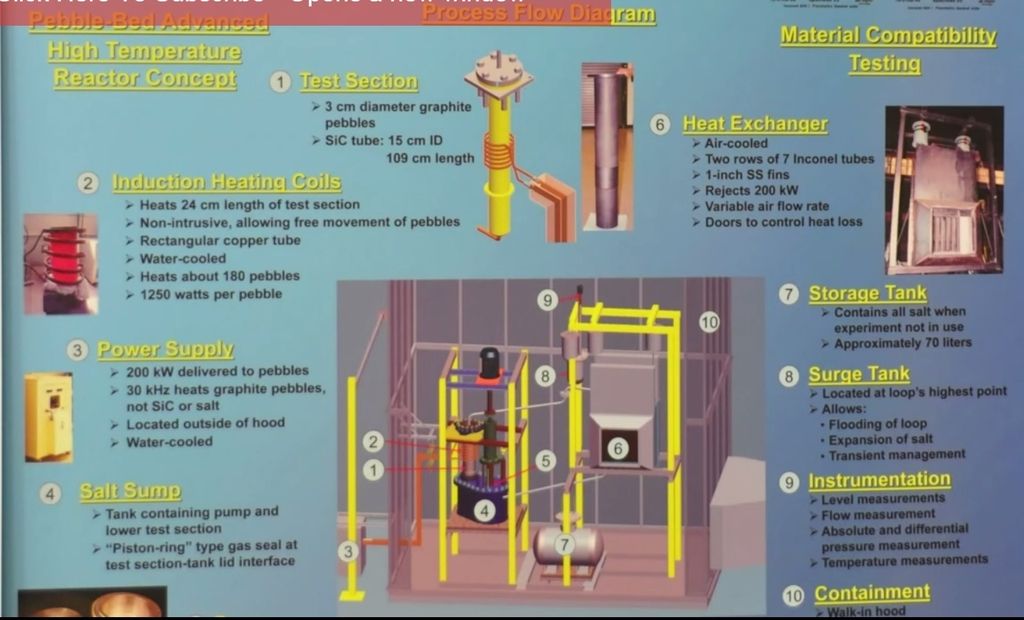Thinking further, I know why they have Lithium Fluoride as the main salt, of all the salts it’s the one with the greatest neutron-slowing action because the elements Lithium and Fluorine are lightweight. The melting point of LiF is 845 °C, of NaF is 993 °C, of KF2 858 °C. These are all too high! Mixing them together in the correct proportions lowers the melting point. The eutectic LiF–NaF–KF (46.5; 11.5; 42.0 mol%) has a melting point at or below 520 °C. The melting point of of BeF2 is 554 °C.
> Testing a pebble bed reactor. The pebbles are of silicon carbide and contain solid fuel “TRISO”
These pebbles are less than 1 mm in diameter. The silicon carbide coating of the pebbles contain gaseous fission products. I think another of the coating layers is graphite.
“Molten salt the only material trialled capable of high temperature at low pressure, which is the unique combination”. “Boiling point could be as high as 815 Celsius”, well, it had better be higher than the temperature of 700 Celsius used in corrosion testing. About 600 degrees in the main reactor, that makes it a high temperature reactor (HTR).
“In homogeneous reactors the expensive process of producing fuel pellets is bypassed” but in Pebble bed reactors the problem is still there. “making a fluoride salt is trivial”. (PS, my idea for an extremely high temperature reactor, too hot for molten salt, was also a homogeneous reactor).
“In the conventional (water-based) reactor design with solid UO2 fuel pellets, a problem is that the solid UO2 is a particularly bad heat conductor, so that means that the centres of the fuel rods get very hot, “about 1000 degrees hotter than the surface, which puts enormous thermal stresses on the assembly”, “you can’t even get close to 100% burn”.
“Hexagonal grid of plates for fuel assembly cooled by liquid salt F+Li+Be”.
“Conventional solid fuel the fuel doesn’t move. Pebble bed if a halfway house where the fuel does move, but not fully with the liquid. Then a slurry where the fuel is in particulates that move with the flow. The final step has the fuel in solution.”
“CASL” is the name for overcoming problems associated with nuclear reactors, problems like power-level-shift, corrosion, mechanical failure, unwanted chemical reactions, geometric distortion, and safety problems.
————————————————
mollwollfumble’s private thoughts on this.
1) I don’t see molten salt reactors replacing water-based reactors for large public power facilities.
2) Keeping in mind that molten salt was initially started as a solution to the “minimum weight” nuclear power source, I see a use for in small power plants such as ships, submarines, possibly trains, and scientific applications that require other properties such as high neutron flux for doping computer chips and for neutron-based imaging. Neutrons penetrate materials better than X-rays and gamma rays, and unlike gamma rays are stopped by the presence of light elements such as hydrogen, helium and carbon.
3) The 232Th to 233U breeder technology is the best long-term power source, simply because 232Th is cheaper and much more plentiful than natural uranium. Clean-up of the radioactive waste is slightly easier, but not much easier. A breeder reactor of any sort requires a reprocessing facility.
4) On the other hand, 232Th technology can be implemented with more conventional types of reactor, it doesn’t have to be a molten salt reactor.
5) I’m not keen on the pebble-bed idea because the pebble manufacture is complicated and expensive. I’d prefer to see the fuel dissolved in the liquid salt, despite the more complicated chemistry.


